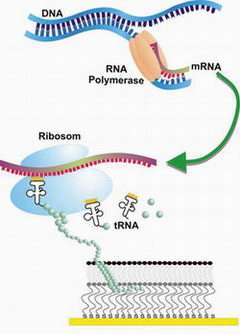Instruction Manual for Creating a Molecular Nose

An artificial nose could be a real benefit at times: this kind of biosensor could sniff out poisons, explosives or drugs, for instance. Researchers at the Max Planck Institute for Polymer Research and the Max Planck Institute of Biochemistry recently revealed a technique for integrating membrane proteins into artificial structures. Membrane proteins have several important functions in the cell, one of which is to act as receptors, passing on signals from molecules in the air, for example, to the cell interior.
They are thus ideal biosensors, but until now were difficult to access in the lab. However, Max Planck scientists have now managed to incorporate in-vitro synthesized membrane proteins directly into artificial lipid membranes.

The senses of living organisms function using various mechanisms, among other things utilizing membrane proteins as receptors. Researchers at the Max Planck Institute for Polymer Research and the Max Planck Institute of Biochemistry have now succeeded in creating biosensors by incorporating such proteins into artificial structures. The membrane proteins are synthesized in-vitro directly from the genetic information introduced to the cell extract.
Previous attempts to create biosensors from membrane proteins failed due to an idiosyncrasy of these proteins: they are not water soluble. In the past, researchers tried to remove the proteins from their biological membranes by solubilising the latter using detergents. However, this destroys the natural folding structure of the protein membranes, which is precisely what makes the proteins so special. "We quickly realized how difficult it is to isolate such membrane proteins. Neither we, nor other research groups, were able to work with them using conventional methods," explains Dr. Eva-Kathrin Sinner of the Max Planck Institute for Polymer Research in Mainz .
Yet the Max Planck researchers found a way around this: they succeeded in incorporating the proteins in an artificial matrix, just as they would be integrated in a natural cell membrane. They achieved this by introducing the developing membrane proteins to artificial lipid membrane systems that mimic natural cell membranes from a statu nascendi, and the membrane proteins actually did simply insert themselves into the artificial membranes. The odorant receptors selected by the researchers were a type of G-protein coupled receptor taken from brown rats. The scientists were also able to prove that the odorant receptors maintained their biological functions by demonstrating the binding of odorants to the receptors. "We now have something akin to an instruction manual on how membrane proteins that were previously difficult to access can be produced and analyzed in their active structure," says Sinner.
The new procedure developed by Eva-Kathrin Sinner and her research group makes it possible, for the first time, to examine the natural functions of such membrane proteins in situ. This is of considerable importance to pharmaceuticals research, as it means that new active agent screenings can now be carried out using receptors that were inaccessible until now. Sinner was awarded the Engelhorn Foundation's 2007 Research Prize for the Promotion of Biotechnology and Gene Technology for the development of this procedure.
Citation: Robelek, R.; Lemker, E.S.; Wiltschi, B.; Kirste, V.; Naumann, R.; Oesterhelt, D.; Sinner, E.-K., Incorporation of in vitro Synthesized GPCR into a Tethered Artificial Lipid Membrane System, Angewandte Chemie International Edition, January 15, 2007
Source: Max Planck Institute for Polymer Research















